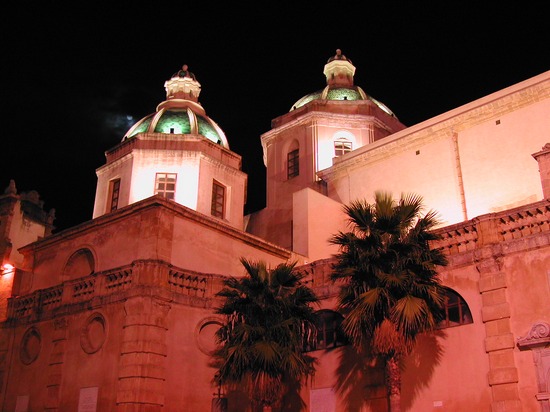Mazara del Vallo


Mazara del Vallo è un comune a venti km da Marsala, affacciato sul Mar Mediterraneo, alla foce del fiume Mazaro e distante meno di 200 km dalle coste tunisine del nord Africa.
Il vecchio "centro storico", un tempo racchiuso dentro le Mura normanne, include numerose chiese monumentali, alcune risalenti all'XI Secolo, e un quartiere a impianto urbanistico islamico tipico delle "medine", chiamato Casbah, di cui le viuzze strette sono una sorta di marchio di fabbrica.
Le attività economiche che lo contraddistinguono principalmente sono la pesca, l'agricoltura e l'industria cantieristica e alimentare, in particolare quella del pesce. Mazara del Vallo è uno dei più importanti e noti porti pescherecci italiani, base di armamento di una flotta di circa 350 grandi motopescherecci d'altura (con circa 4.000 pescatori imbarcati), che rientrano ogni 20-30 giorni dalle grandi battute di pesca.
A Mazara risiedono, spesso con le famiglie, circa 3.000 immigrati, provenienti in larga parte dal Maghreb, impiegati da oltre 25 anni nelle attività pescherecce, agricole e artigianali della città. Essi risiedono principalmente nel centro storico cittadino di matrice araba.
Mazara è altresì salita alla ribalta delle cronache nel marzo 1988, quando un peschereccio locale, comandato dal capitano Francesco Adragna, ha recuperato, a circa 480 metri di profondità nelle acque del Canale di Sicilia, una scultura bronzea di oltre 2 metri, risalente al periodo ellenistico, conosciuta con il nome di Satiro danzante. La statua, dopo essere stata restaurata è esposta a Mazara nella Chiesa di Sant'Egidio.
Mazara del Vallo è sede di numerosi luoghi di interesse storico, che rievocano le diverse influenze culturali che ne hanno caratterizzato la storia.
La Basilica Cattedrale sorse in epoca normanna, al posto di una precedente moschea per volere di Ruggero I, in seguito alla creazione nel 1093 della diocesi. Venne ricostruita completamente alla fine del XVII Secolo in forme barocche, per opera di Don Pietro Castro. All'interno si conserva il gruppo statuario rappresentante la Trasfigurazione di Antonello Gagini.
La Chiesa di San Nicolò Regale del 1124 e la Chiesa della Madonna delle Giummare dell'XI secolo, entrambe di chiara matrice arabo-normanna.
L'Arco Normanno, che è ciò che resta dell'antico castello normanno che sorgeva nel centro storico della città.
Piazza della Repubblica, la principale piazza cittadina sulla quale si affacciano, oltre alla Basilica Cattedrale, il Palazzo Vescovile del XVI secolo e il Palazzo del Seminario vescovile, del 1710.
Il Museo diocesano, inaugurato nel 1993 in occasione del nono centenario della fondazione della diocesi, raccoglie il ricco patrimonio di argenti della cattedrale.

In 1072, Mazara was conquered by Normans, headed by Roger I. During that period - in 1093, the Roman Catholic Diocese of Mazara del Vallo was instituted.
After the death of Emperor Frederick II, Sicily passed to the Angevins, then followed by the Spaniards of Aragon. The Aragon period (1282-1409) is characterized by a political, economic and demographic decline of Mazara. The city passed under the control of the House of Savoy in 1713, a reign which lasted only five years, being replaced by the Austrians (for 16 years) followed by the Bourbons. In 1860 the city was finally conquered by Giuseppe Garibaldi and the Mille, thus joining then newly formed Kingdom of Italy.
The city was known as Mazzara del Vallo until the World War II period, following which the spelling was changed to Mazara del Vallo.
Today Mazara is widely considered to be one of the most important fishing centres of Italy; tussles about fishing rights, especially with the North-African countries, figure large in the town's recent history, boat sequestrations being a common event. Currently the fishing business in the city seems to be withering, mainly because of the increasing lack of people willing to work on boats.
Mazara del Vallo is among the Italian cities with the highest percentages of immigrants; it is estimated that the city hosts at least 3,500 registered immigrants, mainly from nearby Tunisia but also the other countries of the Maghreb. They tend to live principally around the old Arab city centre (the Casbah). There exists a local school, managed by the Tunisian government, at which only Arabic and French are taught as languages. This has led to some controversy. It must be noted that most of the local schools show openness to Arab culture, even providing Arabic language classes for both Italians and Arabs, and encouraging integration with the autochthonous students. The local city council also provides a seat reserved for a representative of Mazara's immigrant community.
Mazara made national news in March 1998, when a bronze statue called the Dancing Satyr (Satiro Danzante) was found off the port, at a depth of 500 meters in the Strait of Sicily by a local fishing boat. The statue is believed to have been sculpted by Greek artist Praxiteles and is now on display to the public in a dedicated museum in the city, after having been on show at the Chamber of Deputies of Rome, and in Aichi, Japan. After this event, the city quickly gained in terms of visiting tourists and a national advertising campaign was mounted with the slogan Mazara del Satiro.
Other attractions include the Norman Arc, that is the remains of the old Norman Castle built in 1073 and demolished in 1880, and a number of churches, including the Royal Saint Nicholas (San Nicolò Regale) Church, a rare example of Norman architecture built in 1124, the Seminary, built in 1710, which surrounds the main local piazza, Piazza della Repubblica, and St. Vitus on the Sea (San Vito a Mare) Church. In honour of St. Vitus, the official patronal saint as well as a native of Mazara del Vallo, the St. Vitus Feast (Lu Fistinu di Santu Vitu) is held every year.
During the summer period, Mazara is also connected via ferry to the island of Pantelleria and Hammamet, in Tunisia.